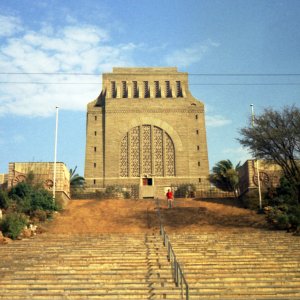Advertisement
Published: June 10th 2022

 Voortrekker Monument
Voortrekker Monument
Voortrekker Monument, Pretoria, South Africa. Built in 1937-1949 to commemorate the Voortrekkers who left the Cape Colony between 1835 and 1854. Eeufees Road.
"Designed by architect Gerard Moerdijk and built between 1937 and 1949, the Voortrekker Monument is a massive granite structure erected in the memory of the Voortrekkers, colonists who set out from the Cape Colony to explore the interior of South Africa".
Africa116p1The major sight in Pretoria is the Voortrekker Monument on a hill overlooking the city. It was built in 1937-1949 to commemorate the Voortrekkers who left the Cape Colony between 1835 and 1854 to settle the interior of South Africa and escape British rule. It is something like a large temple, and I suppose that is what it was to the Afrikaners. The inside space is surrounded by a 27-panel marble frieze depicting the Great Trek. A cenotaph commemorates those who lost their lives during the Great Trek and settlement of the Boer republics. Another frieze on the wall outside depicts a covered wagon train.
Pretoria is the administrative capital of South Africa, the seat of the President and the executive departments. (Bloemfontein is the judicial capital and Cape Town is the legislative capital.) The Union Buildings were built in 1913 to house the South African (the Union of South Africa) government administrative departments. The buildings form a right and a left office building with a curved amphitheater connecting them The office of the president is located in the left wing building. On Church Square was the Ou Raadsaal (Old Council Hall). Pretoria had been capital of the Transvaal Republic

 Ou Raadsaal
Ou Raadsaal
Ou Raadsaal - Old Council Hall. The Ou Raadsaal housed the Volksraad, the parliament of the South African (Transvaal) Republic, from 1891 to 1902. Church Square.
IMG00393p1(South African Republic) from to 1902. The 1891 Raadsaal was the capitol building.
Sunday we attended South African tribal dance exhibition at one of the Witwatersrand gold mines. The Mine Dances were held on Sunday afternoons and mine workers of different tribes performed in the dances. The mines advertised the dances as a recreational activity by the miners, but the miners probably were required to participate. Apartheid was evident here, too, as White and Black spectators were seated in segregated sections. Nevertheless, the dances were a colorful spectacle and appeared to an outsider to be a representation of the dancers' cultures.
Advertisement
Tot: 0.078s; Tpl: 0.014s; cc: 13; qc: 31; dbt: 0.0426s; 1; m:domysql w:travelblog (10.17.0.13); sld: 1;
; mem: 1.1mb

 Voortrekker Monument
Voortrekker Monument
 Ou Raadsaal
Ou Raadsaal
















